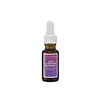What's inside
What's inside
 Key Ingredients
Key Ingredients

 Benefits
Benefits

 Concerns
Concerns

 Ingredients Side-by-side
Ingredients Side-by-side

Rosa Canina Seed Oil
EmollientLinum Usitatissimum Seed Oil
PerfumingSalicylic Acid
MaskingCalophyllum Inophyllum Seed Oil
AntimicrobialHippophae Rhamnoides Fruit Oil
Skin ProtectingBisabolol
MaskingRetinyl Palmitate
Skin ConditioningDocosahexaenoic Acid
Skin ConditioningColeus Forskohlii Root Oil
EmollientPunica Granatum Seed Oil
EmollientTocotrienols
Skin ConditioningTocopherol
AntioxidantAstaxanthin
Skin ConditioningLycopene
AntioxidantXanthophylls
Skin ConditioningThioctic Acid
AntioxidantZea Mays Oil
EmulsifyingAlpinia Nigra Root Powder
HumectantCedrus Deodara Wood Oil
MaskingRosa Canina Seed Oil, Linum Usitatissimum Seed Oil, Salicylic Acid, Calophyllum Inophyllum Seed Oil, Hippophae Rhamnoides Fruit Oil, Bisabolol, Retinyl Palmitate, Docosahexaenoic Acid, Coleus Forskohlii Root Oil, Punica Granatum Seed Oil, Tocotrienols, Tocopherol, Astaxanthin, Lycopene, Xanthophylls, Thioctic Acid, Zea Mays Oil, Alpinia Nigra Root Powder, Cedrus Deodara Wood Oil
Squalane
EmollientLinum Usitatissimum Seed Oil
PerfumingRosa Canina Seed Oil
EmollientLecithin
EmollientSalvia Hispanica Seed Oil
MoisturisingPunica Granatum Seed Oil
EmollientArgania Spinosa Kernel Oil
EmollientTocotrienols
Skin ConditioningTocopherol
AntioxidantAstaxanthin
Skin ConditioningLycopene
AntioxidantXanthophylls
Skin ConditioningThioctic Acid
AntioxidantBeta-Carotene
Skin ConditioningDocosahexaenoic Acid
Skin ConditioningCeramide NP
Skin ConditioningCholesteryl Oleyl Carbonate
Skin ConditioningCholesteryl Nonanoate
EmollientCholesteryl Chloride
Skin ConditioningBHT
AntioxidantPhytosterols
Skin ConditioningOryzanol
Skin ConditioningSqualane, Linum Usitatissimum Seed Oil, Rosa Canina Seed Oil, Lecithin, Salvia Hispanica Seed Oil, Punica Granatum Seed Oil, Argania Spinosa Kernel Oil, Tocotrienols, Tocopherol, Astaxanthin, Lycopene, Xanthophylls, Thioctic Acid, Beta-Carotene, Docosahexaenoic Acid, Ceramide NP, Cholesteryl Oleyl Carbonate, Cholesteryl Nonanoate, Cholesteryl Chloride, BHT, Phytosterols, Oryzanol
Ingredients Explained
These ingredients are found in both products.
Ingredients higher up in an ingredient list are typically present in a larger amount.
Astaxanthin is a carotene pigment and red pigment. It is a promising antioxidant with a ton of skin benefits.
This antioxidant has great anti-aging benefits by blocking the following:
Astaxanthin is also great at soothing skin due to its ability to block molecules that signal inflammation. It is currently being studied for preventing chronic inflammatory diseases.
Plus, a study from 2012 found Astaxanthin in liposomes protected mouse skin from UV-damage.
Fun fact: Astaxanthin is responsible for giving salmon a pink color.
Learn more about AstaxanthinDocosahexaenoic Acid isn't fungal acne safe.
Linum Usitatissimum Seed Oil is the expressed oil from the dried ripe seed of the Linseed, Linum usitatissimum L., Linaceae
Lycopene is an antioxidant.
Punica Granatum Seed Oil is created from the seeds of the pomegranate. Pomegranate seed oil helps hydrate the skin, is anti-inflammatory, and contains antioxidants.
Pomegranates are rich in fatty acids, including an unsaturated fatty acid by the name of Punicic acid. Other components of pomegranates include Vitamin E, Vitamin C, and bioactive lipids such as phytosterols, phospholipids, and triterpenes. Punicic acid helps soothe inflammation.
As an emollient, pomegranate oil creates a thin film on the skin. This film helps prevent moisture loss, keeping your skin hydrated.
Learn more about Punica Granatum Seed OilRosa Canina Seed Oil comes from the seeds of the dog-rose plant. It is an emollient.
Emollients help hydrate your skin by trapping moisture in. They create a thin film on the skin to prevent moisture from escaping.
Rosa Canina Seed Oil contains phenolic compounds, carotenoids, Vitamin C, linoleic acid, and other fatty acids.
Due to the fatty acid content, this ingredient may not be fungal-acne safe.
Learn more about Rosa Canina Seed OilThioctic Acid is an enzyme and antioxidant. A more common name for this is Alpha Lipoic Acid.
Alpha Lipoic Acid can be naturally found in the mitochondria of every cell.
Antioxidants help fight free-radicals. Free-radicals are molecules that may damage your skin cells. The antioxidants in Alpha Lipoic Acid have been shown to fight damage from cigarette smoke.
Studies also show Alpha Lipoic Acid plays a role in wound healing.
Thioctic Acid will break down when exposed to sunlight.
Many foods contain thioctic acid, including tomato, brussel sprouts, spinach, and broccoli.
Learn more about Thioctic AcidTocopherol (also known as Vitamin E) is a common antioxidant used to help protect the skin from free-radicals and strengthen the skin barrier. It's also fat soluble - this means our skin is great at absorbing it.
Vitamin E also helps keep your natural skin lipids healthy. Your lipid skin barrier naturally consists of lipids, ceramides, and fatty acids. Vitamin E offers extra protection for your skin’s lipid barrier, keeping your skin healthy and nourished.
Another benefit is a bit of UV protection. Vitamin E helps reduce the damage caused by UVB rays. (It should not replace your sunscreen). Combining it with Vitamin C can decrease sunburned cells and hyperpigmentation after UV exposure.
You might have noticed Vitamin E + C often paired together. This is because it is great at stabilizing Vitamin C. Using the two together helps increase the effectiveness of both ingredients.
There are often claims that Vitamin E can reduce/prevent scarring, but these claims haven't been confirmed by scientific research.
Learn more about TocopherolWe don't have a description for Tocotrienols yet.
We don't have a description for Xanthophylls yet.